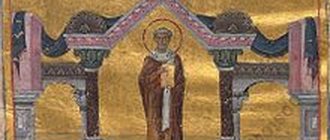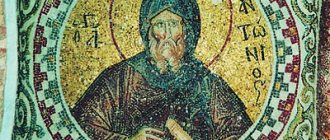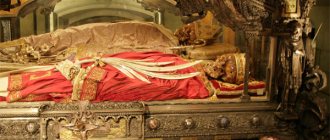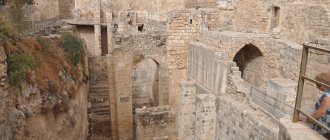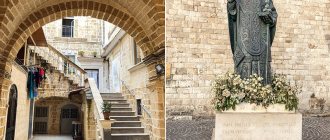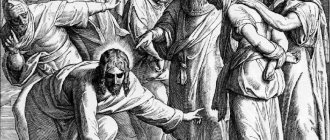Draw a temple step by step - How to draw a church, temple, cathedral with a pencil step by step?
This lesson is quite complicated, because to draw a temple with a pencil step by step, you will need a lot of time and patience. There are a lot of small details in this drawing, which are the architectural decorations of the temple.
Despite the fact that when drawing they most often do not use a ruler, we still really need it. A temple is, first of all, an architectural structure, which means its design consists of many clear and even lines.
To convey them more accurately, we need a ruler.
On our website you can also learn how to draw Easter cake with eggs
– a drawing of medium complexity and
a drawing for Easter
– a fairly simple drawing.
So, let's start drawing the main lines of the future temple with a pencil. If you doubt that you can correctly transfer the proportions onto paper, then simply measure all the lines with a ruler and transfer them in the appropriate ratio to the paper.
Now let's draw a block on top and a small narrow rectangle at the bottom. We highlight each new element in red to make it easier for you to draw each new element.
Now let's draw two rectangles on the left and right, and in the middle we need to draw several geometric shapes that will be the basis of the middle part of the temple.
We add windows - there are 10 of them and they are all in the shape of an arch; we also add elements at the very top.
In this picture we add a few more decorative elements.
Now we draw the domes - this is one of the distinctive features of temples and churches from other buildings. At the end of each dome we will draw a circle, on which we will then draw a cross.
In this step we need to draw a lot of columns. They are located both on the left and on the right, and there are also a lot of them in the center of the temple - look carefully at the enlarged hint so as not to miss anything.
Let's draw further. It is in this step that you can see how we decorate all the domes with crosses and circles inside a large circle. We also add some more details.
We decorate the upper part of the temple with elements.
At this stage, we will draw decorative elements on each column of the temple with a pencil. We will also add one internal arch in each of the ten windows.
Well, the temple is ready. Now you can start coloring it.
SIMILAR LESSONS
vserisunki.ru
How to draw the Church of the Intercession on the Nerl with a pencil step by step
Already drew +5 I want to draw +5
Thanks +165
Step 1
At the bottom of the sheet we put a point from which we draw three lines, one vertical and two inclined at approximately 15 degrees.
Step 2
Based on the lines constructed in the previous step, we complete the parallelepiped, its base and two front side edges.
Step 3
We draw a vertical line to build a dome on it and make four notches. We also draw four more verticals on the sides of the parallelepiped; on their basis, further elements of the building will be built.
Step 4
We are building a church dome. We draw its base in the form of an arc, then a tower emerging from this base, and finally we build the main elements of the dome itself using arcs and ovals. On the side wall of the building we use several arcs to emphasize the protruding elements of the church in the form of semi-cylinders.
Step 5
We are completing the dome of the building, emphasizing its shape. A series of arcs show the shape of the upper arched protrusions of the church walls; on the left side, several arcs will form small domes of the cylindrical protrusions depicted in the last stage. On the right side, using several lines, we divide the wall into several parts, each of which will house certain architectural elements.
Step 6
We are finalizing the upper tower, depicting a row of small oval-shaped windows along its perimeter. We emphasize the shape of some of the upper projections of the walls, giving them a small volume. On the left side, on each of the ledges, draw one window and draw cutouts in the towers with several vertical lines. On the right side we also draw windows, we draw cutouts in the walls and at the bottom we draw the church door.
Step 7
We draw a cross over the dome and shade it, draw a shadow falling from it onto the dome, which we also shade. We depict ornaments on the tower and apply the necessary shadows. We draw a falling shadow from the tower on the dome, which is its base. Draw shadows in windows and doors. We shade the edge closest to us, as if dulling it.
Step 8
Detailed work on small details on the domes, tower and walls of the church. Hatching a building to give it life and volume.
After applying the shadows, the domes turn out almost black, only a small part on the right remains unshaded - highlights that give shine to the domes. We also enhance the shadows in windows and doors.
On the left side of the building, we add volume to each protrusion by shading a small part on the left. In other places we apply lighter shading.
Step 9
At this stage the lesson is completed. You can leave a pencil sketch or add color to the drawing. We wish you creative success!
purmix.ru
How to draw a cathedral with a pencil step by step
Depicting architecture requires a lot of effort. For beginners, this is not as difficult as portraits, for example. This is because painted buildings are perceived differently from people we know, and here mistakes are less visible.
I will show you how to draw the Assumption Cathedral step by step. I prohibit using a ruler or any other tools that make it easier to draw straight lines! Learn to draw by hand.
When your hand gains experience and confidence, you can use any techniques. Now draw the cathedral on your own!
Step one. We will show on paper the place where the cathedral and trees will be located. Step two. We draw the main components of the building. Step three. Let's detail each of these parts.
Take your time, carefully work out every detail: crosses, domes, windows and even trees. Step four. To make the landscape realistic, we will add a background and shadows.
Check out my other tutorials on drawing buildings, they are even better:
- Drawing a church;
- Buddha Temple;
- Kremlin;
- Shop;
- Big Ben;
TrustNo1
Especially for DayFun
dayfun.ru
⛪How to draw a church step by step with a pencil
In this lesson I want to show you in detail how to draw a church with a pencil step by step. A drawing made with colored pencils will be shown. We hope you enjoy it! With the help of several colors you will be able to build a full-fledged structure.
The master class consists of step-by-step drawings with detailed descriptions, which greatly simplifies the task. Here you can learn how to draw a church with a pencil step by step for beginners. Also on the lessdraw website.
com you can learn how to draw a house along with our lesson.
Stages of work: Using squares and a rectangle, we will construct the general shape of the drawn church.
There will be a long vertical rectangle on the left, a horizontal square on the right and a large rectangle on the bottom.
To draw a church with a pencil beautifully step by step, choose high-quality materials - plain paper, pencils or paints. You can use a ruler to draw the church neatly;
Source: https://club-detstvo.ru/raznoe/poetapno-narisovat-xram-kak-narisovat-cerkov-xram-sobor-karandashom-poetapno/
Instructions for drawing architectural objects or how to draw a church
Don't know how to draw a temple with a pencil or paints? This lesson will help you create this element step by step, using familiar and accessible tools - an eye, a ruler, paints and pencils!
In fact, creating such a drawing is not so easy. The whole point is that the artist will have to depict a number of elements of different sizes and shapes, the totality of which will create the unique structure of the church.
Historical reference
The period of the birth of Christianity does not tell us about modern churches, because earlier people prayed in basilicas - specialized buildings - prayer houses. During the period when Christians had to hide their faith, people prayed completely underground, often in the catacombs.
The structures that are now familiar were formed only during the period when Christianity came into its heyday. Considering that the teaching talks about the church as the temple of God, it is not surprising that outwardly all such buildings differ from ordinary buildings.
The main distinguishing features are domes, crosses, and an internal altar.
The cross in Christianity is a symbol of Jesus Christ, who managed to defeat death and ascend to heaven. At the same time, the domes are a symbol of heaven, where, according to beliefs, God now lives. The place where the church was built, in turn, is considered sacred, and even if the monastery of God was previously destroyed, modern descendants are trying to restore it in the same place.
Drawing an Orthodox Christian temple
It's time to learn how to draw a church. To create a drawing, you should purchase in advance
such tools and materials:
- Whatman paper (preferably thick);
- Wax crayons;
- A glass for water (you can use a specialized glass - a sippy cup);
- Natural brushes;
- Watercolor paints;
- Pencils;
- Eraser.
If the building that you decide to reproduce stands on water, such as the Temple of the Intercession, you should determine the horizon line in advance and separate the land from the water. Next, you should create the outlines of the future structure and highlight the reflection in the water.
All this is done using colorful wax crayons. The walls should remain white, the dome yellow, and the reflection should not be painted over. Near the main element of the design there may be vegetation - trees, shrubs, or the sun in the sky.
Decorate the water surface with ripples in light blue or white tones and move on to paints.
You should work with watercolor paints easily, while applying the paint in large strokes. Mark the earth, sky, water, maintaining color balance. You should not make the sky darker than the water, and the earth lighter. You can sketch crayons with paint, because after the drawing has completely dried, they will appear.
Method No. 2
Having become familiar with architectural objects related to Orthodoxy and Christianity, some patterns become clear, on the basis of which you can quickly and easily create a high-quality drawing. A church can be drawn even without focusing on a specific real object. For example, you can take a regular sheet of paper, in A4 format, and start creating a temple from the center line in the middle of the drawing.
In order for the drawing to acquire the correct shape, you need to create a parallelepiped with a base at the bottom and a pointed top. At the top, accordingly, there will be a dome consisting of 2 inclined lines, which in turn extend from the base.
Vertical lines will help create a bell tower. Once the basic lines are created, you should begin creating the semicircular elements of the dome, which are mirrored relative to the center line.
The lower tier of the temple will become the end of the bell tower, and the lower part of the dome will become its ceiling.
On one side you can add half-cylinders attached to the wall. A rounded roof consisting of numerous arches will begin from them. Windows should be placed on the upper and lower tier and given an elongated shape with a rounded top. On the opposite side of the arches, draw a door.
When starting shading, pay attention to the shading of the towers and domes, windows and doors. Thanks to the correct direction and density of the shadow, the church will acquire the desired volume and come to life in the drawing. Don't forget to get rid of the sketch lines!
Reviving the drawing with color
In order for the drawing to become colorful and realistic, all details should be painted. Paint or ink is perfect for this purpose. When working with paints, you should use a brush and follow a number of rules described in other lessons, but ink can also be used with your fingers. So, first you should add some water to the mascara,
and then rub the color in the necessary places:
- The roof and dome are yellow;
- Walls – green;
- We complement the space near the roof with gray color.
After drying, the drawing can be framed or presented as a gift to a friend.
Source: https://kch-school.ru/articles/instruktsiya-po-risovaniyu-arkhitekturnykh-obektov-ili-kak-narisovat-tserkov
Preaching with pencil and brush
He serves the Lord with prayer and tells children about the beauty of God's world with the help of paints. Hierodeacon Paisiy (Novozhenov) from the Holy Dormition Monastery in the city of Staritsa near Tver is an amazing person. The author of books and films on spiritual topics, he is engaged in icon painting, makes watercolor illustrations for children's books and runs an art studio at the monastery educational institution. The drawings of Father Paisius’ students are lively and pure, touch the soul, evoke tenderness and joy. A conversation with him about how and what the monk-artist teaches the children.
Hierodeacon Paisiy (Novozhenov) at work
– Father Paisiy, where do the guys come to the monastery circle from? Are these the children of parishioners?
– The great joy is that my current students are absolutely secular children. These are ordinary schoolchildren who do not go to church, children who are not from Orthodox families. There are even a few Muslim girls. To be honest, I don't know how this happened. This is some kind of miracle! Just think: secular children come to a monastery to see a monastic teacher. Sami! Not because their parents brought them. This is a wonderful opportunity to tell the children about God and Orthodoxy.
The most difficult option for me is mixed groups. They are attended by children aged 6–14 years. There are exactly 50 children, they are divided into two groups of 25 students. The students are mostly schoolchildren in grades 4–7, but there are older and younger artists.
– How did you recruit current students? And how long have you been teaching art?
Classes
– In 2003, I began teaching fine arts at the Palace of Culture. I liked this work so much and inspired me so much that now I can’t imagine my life apart from teaching. Since then, I have been constantly involved in organizing clubs, studios, Sunday schools and electives - in Sergiev Posad, Rzhev, Tver. Now in Staritsa, in the monastery where I was sent six months ago.
When I arrived in this city, the first thing I did was go to the schools - we have three of them. I walked through the classes, in each of them I opened a large folder with the best children's drawings of previous students and showed it to the children. He invited everyone to the art studio at the monastery. A lot of schoolchildren came - as many as 44 people! Then they started bringing friends, brothers and sisters, and in the end we have 50 children.
Students
Once upon a time, when I was in second grade, a young art teacher from an art school came to class, showed me her graphic works, and invited me to school. I liked the drawings so much that I went to study. And now I use this technique myself.
- Father, how are you conducting your classes? What do you pay attention to?
– The most important and most difficult thing is to create the right learning atmosphere. On the one hand, the teacher needs to try to make it interesting for children - so that a good, cheerful, friendly environment is formed in the classroom. It is also important to structure lessons so that students acquire skills and knowledge, and reveal talents.
Class
I constantly tell them that they must develop their talents, be purposeful, work every day on self-development, try to determine their inclinations. And there are already small glimpses. One day a little girl came up to me, her name is Mashenka, and said in a whisper: “Father Paisiy, it seems I have my own talent.” Let me explain what I'm talking about. What I draw on the board, this student redraws exactly. The other kids mostly improvise on the theme “what Father Paisius showed us,” and this, of course, also has its own meaning. Unique things are obtained, sometimes even in the style of Picasso. And this girl very accurately follows what is shown on the board, correctly conveys the proportions and contours, and even guesses the angle of the line. It was as if my drawing had been transferred to her piece of paper - only in a smaller form. Before that, I constantly said: you have a special talent, develop it. She only giggled in response. And then I thought of it in my little head.
By convincing children that they are gifted, I do not provoke pride, but teach them to take a responsible attitude towards their talents
Here I would like to clarify: by convincing the children of their talents, I do not provoke pride in them, but teach them a responsible attitude towards their talents. Gifts are from God. And we cannot neglect them, but, on the contrary, we must increase them. Therefore, I constantly instill in children that time is precious, that life is built from a young age.
The smallest student
Sometimes I take the book “The Tale of Lost Time” by Evgeniy Schwartz and read excerpts from it aloud while they draw. So that the children can develop a deeper understanding of the preciousness of time, especially in adolescence, when their future life is being formed. Sometimes, unnoticed by others, I lean over someone, helping to draw, and quietly say some useful word.
– How do you deal with mischievous people?
Hierodeacon Paisiy (Novozhenov)
“If something bad is clearly manifested in one of the kids, without making fun of him in front of the whole class, I give advice in private.” Even big spoilers must be tolerated. Reasonable, of course. But you shouldn’t cut off a diseased branch ahead of time, while there is still hope of healing. I have a good example on this topic. A student came to me - a boy with the most bad behavior. In winter, when I left school, he would throw a lump of snow at me, the teacher and the clergyman, in the back. And he did a lot of other bad things. Both the principal and the teachers constantly pointed him out to me and prepared him to be expelled from Sunday school.
I thought: well, I’ll put up with him a little longer. I was sure that the boy was doing this out of stupidity, not out of malice. After all, I felt giftedness and passion in him. I think it was because he was very emotional, hyperactive. I called him for conversations, told him what he needed to hear about his behavior, tried to reach the very depths of his heart. And, you know, soon there was victory. Here, perhaps, it was not our conversations that were the reason, maybe some life circumstances, but soon the boy became more serious. This, of course, is the Lord working on those who show hope. This spoiler became the best student. Better even than those who were considered the most well-behaved. And now he is studying in his third year at the Moscow seminary. Good guy, taller than me.
Students in front of the teacher are in full view. In the studio you can see very clearly what bad habits someone has. It seems to them that I don’t notice them, I’m standing half-turned, but I see everything. I understand who is a spoiler, who is cunning, who is ready to offend others, who is despondent because there is discord in the family between parents. Today they all lack the kindness of adults, some kind of tenderness.
– How can we teach children themselves to be kinder if there is not enough kindness around them?
- How? I don't know. But I never offend children or scold them. I hope that this spirit of kindness will be communicated to them without teaching, passed on as a state. You can teach through both silence and sympathy, listening to their childhood experiences about who in the yard said and did what and what to do now.
In extreme cases, if they start to indulge too much, I use the “complaining” technique. Like a good old grandmother who repeats: “Oh, what should we do now?!”, I begin to walk around them and complain. They realize that they have crossed boundaries and calm down.
I hope the guys will remember how to get out of unpleasant situations by covering the mistakes of others with love
And when someone knocks over a jar of gouache onto the snow-white floor, I don’t look at them with frenzy, saying, “What have you done!”... Out of habit, they freeze and look at me, eyes wide open. Because they know the equivalent of punishment in such cases from the experience of a comprehensive school. But this is where I have a chance to show how the teacher takes their blame. I immediately calm them down, carry a bucket and start washing the floor. And they join joyfully and, like obedient angels, wipe everything clean. And this is how we keep each other on our toes. I really hope that when they become adults, they will remember how to get out of unpleasant situations without scandals and screams, but by covering up the mistakes of others with love.
Every time the guys stop drawing and start talking about something, laughing, joking, it seems to me that the strict order of the lesson is being violated. At these moments I remember the engraving by Pieter Bruegel: “If the teacher is a donkey at school.” It depicts a donkey in a teacher’s caftan, and around him children are chaotically doing whatever they want. This is, of course, unacceptable. The lesson must be systematic, with discipline. But without bending, without tightening the nuts. Colleagues often tell me: “Be stricter with your children.” But what does “stricter” mean?
More than half of the students do not have fathers because their parents are divorced. This is a tragedy for a child. One boy does not even have a mother; she abandoned him; the boy is being raised by his grandmother. Another boy’s mother died in an accident... Well, how can we be strict with these guys, what kind of statutory discipline should we impose?!
Tea party
Sunday school is a good time, and it will be remembered for the rest of your life.
Sunday school is a different mood, a fun lesson in good communication. This time should be especially memorable and enjoyable. It is not necessary to provide a lot of information here, to arrange drills and cramming on the topic “what color should the lectern be.” The main thing in Sunday schools is to teach the spirit of a moral good life. Even if sometimes classes are carried out in a funny way, but with all this, a cultural space is created, a creative cultural and ethical field that shapes the souls of children. This good time will be remembered by the children for the rest of their lives. And it doesn’t matter that in such a lesson the student may not write anything down on the white sheet of the notebook. The child contemplated life itself and rejoiced in it, looked at the faces of his comrades and laughed heartily, and his memory turned out to be a notebook, a wonderful day remained in it, and this memory will support him in the future in all the hardships.
What I mentioned in several examples above are some of my principles that I came to while working with children.
– Father Paisiy, what is the global goal of your pedagogy?
– I am sure that art can transform a person’s soul, instill a sense of justice, and encourage him to perform noble deeds. Through daily improvement in the sciences and arts, students come to understand the laws of spiritual life. Subsequently, someone will become a doctor, someone a teacher, and someone a scientist, but everyone will gratefully remember their teachers of music and drawing, who inspired them to the feat of life, who managed to instill in them an understanding of the beauty of the world and the greatness of the human soul.
– Where did you learn painting yourself?
– Before the icon painting school, I was lucky enough to study as a painter-teacher at the Tver Art School named after Alexei Gavrilovich Venetsianov. Before becoming a monk, he studied at the surprisingly interesting icon painting school at the Moscow Theological Academy in the Trinity-Sergius Lavra. The Lavra is a unique place for Russian Orthodox culture. Outstanding creative people gather here: the most experienced icon painters, masters of restoration and gold seamstresses, regents, philologists-editors, composers, directors, photographers, missionaries, talented teachers, professors, art critics, writers, thoughtful monks and prayer books.
For five years we studied ancient Russian painting, made lists of the most ancient icons of the Pereslavl Museum, the Rostov Kremlin, the Novgorod Museum, the icon hall of the Tretyakov Gallery, and visited ancient monasteries located in the “Golden Ring” of Russia. All this gave a good idea of the essence of Russian Orthodox art and instilled an understanding of the truly lofty and beautiful. The icon painting school taught traditional icon painting techniques, monumental painting - frescoes, and icon restoration. Everything that I learned and saw there is very helpful in my work on manuals on Orthodox culture.
The training time became an invaluable time to get acquainted with the thousand-year heritage of the culture of Holy Rus', its temples and paintings - from Staraya Ladoga to Yaroslavl. We talked with the Lavra elders - schemamonks and elder archimandrites, and talked with interesting people. And to the best of our ability, we drew spiritual wisdom from them.
I believe that it is in such educational institutions that correct education is realized, when, along with intellectual development, a relatively healthy spiritual life takes place.
– And when you started teaching children how to draw, did everything work out right away?
Students
– Of course, at first I made a lot of mistakes. But through this experience I understood better: it is necessary to thoroughly study the methodology and history of pedagogy. For this reason, four years ago I decided to enter Tver University at the Department of Theology of the Faculty of Education. And now I’m glad I did it. This was extremely necessary in order to take a more competent approach to preparing lessons for schoolchildren.
Currently I am working on a program for teaching fine arts in Sunday schools. For now the work is in limbo. In my opinion, before hastily publishing theoretical manuals, they need to be tested, refined, taking into account realities, and only then released.
Teaching in Sunday schools is, in principle, not an easy task. Fine arts teachers, for example, need knowledge in the field of world artistic culture and church art. The theory received in universities needs to be translated into categories that children can understand. One day, one of the guys in class asked why the distances in the landscape always seem blue, because the trees that grow there are green. I remembered the interesting book “Painting” by J. Vibert, which talked about the refraction of light, the types of rays, their length and the nature of passage through various media. I started telling the children about all this. The little guys, 7–9 years old, looked at me in bewilderment. And I kept talking, could not fully express my thoughts clearly, in the end I was completely confused and barely completed the explanation. The students looked at me dumbfounded. I realized that I had confused them with complex explanations and they were unlikely to catch anything.
Explanation of material
It is necessary to speak to children not only in the language of words they understand, but also in the language of concepts accessible to their perception.
This incident made me take a more serious approach to the issue of adapting the theory of fine art. We need to speak to children not only in the language of words they understand, but also in the language of concepts that are accessible to their perception.
However, it is not always possible to find teaching aids on the desired topic. Therefore, I am already accustomed to the fact that I often have to develop certain lessons myself. I am sure that over many years of teaching, many of my fellow teachers come up with interesting ideas and techniques. I would like to find a platform where I could meet with colleagues and discuss current problems in teaching “Fundamentals of Orthodox Culture”, “World Artistic Culture”, fine arts, and the history of Christian art. I don’t consider myself a professional in the field of teaching at all, but I am looking for like-minded people with whom I can discuss the problems of this area.
From the notes of Father Paisius
Children's drawing
I told the kids about the history of our monastery, about how 900 years ago two monks came here, developed the territory, and built a wooden cell. He also told about how the fire happened in the monastery. In essence, the stories of the founding of all Russian monasteries are similar. Without fail, the first monks, when they arrived, quickly built small temples, and fires were always a typical occurrence. It is interesting that the children, these little sensitive analysts, surprisingly perceptively depicted everything they heard step by step.
The first drawing was dedicated to a skinny ascetic monk with a pickaxe in his hand. He sullenly hammered away at the limestone mountain. There is a lot of limestone in Staritsa, and there was a large mining of white stone here. One of the boys asked: “Can it rain?” How accurate! This is also an image of temptations and difficulties that are always present during the founding of monasteries.
Children's drawing
Another boy drew several lightning bolts in the sky, and one of them hit the monk right in the head. Skufja saved him. The strong monk continued his work as before, and the boy explained that in those days there was no lightning rod. I allowed the presence of such energy. After all, grace is also a kind of Divine energy that helps in deeds. However, I became wary: “What will they come up with next?”
Children's drawing
The girls reduced all the severity to nothing. The sun shone in their drawings, the earth blossomed after the rain. One girl asked: “Can there be a dog there?” She carefully depicted a spotted Dalmatian puppy next to the black figurine of the hermit. I would never have thought of this. Soon all the girls' drawings depicted Dalmatians, flowers, roses, and birds. In general, in the end we founded a cheerful monastery.
***
When I go and knock on the wooden beater, calling for service, I see several dozen wonderful sparrows perching on the electrical wires, they are not afraid of my knock, they look with curiosity and chirp. Looking at them, I think that the monks are the wires of a power plant through which spiritual energy moves to the cities. The wires are simple in appearance, and small birds can sit safely on them, but at the same time, the power that passes through them then moves bridges apart, illuminates the streets, and turns on the lights in thousands of apartments. I knock on my beat, remain silent and think: how to connect the broken bridges between God and hundreds of our compatriots who do not know Jesus Christ? how to illuminate the dark streets of false teachings with the light of Christ, in the darkness of which so many people wander today?
How to draw a temple? Step-by-step instruction
Today, young artists and their parents have another task: to draw a temple with a pencil. This is both difficult and simple at the same time. Depending on how you approach it.
It will take quite a lot of time and patience, because the task contains quite a few small details, which are the architectural elements of the temple. The structure itself is geometrically clear, consisting of simple and complex figures.
Therefore, to more accurately convey the image, we will need a ruler and a good eye.
But first, a little history
At the birth of Christianity, churches were not built, and believers had to pray in special buildings - basilicas. Then came the times of persecution, and Christians hid and prayed in catacomb dungeons.
And only over time, the modern, familiar type of structure was formed. It is believed that the temple is the house of God. The Lord is invisibly present in him.
A temple or church differs from an ordinary house in that there is an altar inside, domes outside, and crosses on them.
Symbolism
The dome traditionally symbolizes heaven, and the cross - Jesus Christ, his victory over death. People believe that there is an angel at the throne of every temple, even if the temple is abandoned. As you know, many of the churches were destroyed during the revolutionary times. And it’s good if they are restored in the same place, since it is consecrated.
How to draw a Christian Orthodox church?
Let's get creative! We chose the simple-looking Orthodox Church of the Intercession. We will need: thick Whatman paper, wax crayons, sippy cup, brushes (preferably natural), watercolor paints, eraser, pencils.
Step 1. How to draw a temple?
First we determine the horizon line. The structure stands near the river and is reflected in the water. We mark the boundary between land and water.
Step 2. Draw the outlines of the temple (you can create a special template for the child). We outline the mirror reflection of the building in the river (in softer tones). We remind you that at this stage we are working with wax crayons.
Step 3. Paint the walls of the temple white. The dome is yellow. The reflection in the river does not need to be painted over. We depict trees on the ground around. There is sun in the sky. We make ripples in the water in light blue or white. This completes the crayons work!
Step 4. Now comes the fun part! Let's put away the crayons, we won't need them anymore. Then you need to soak the watercolor and paint the earth, sky, water with sweeping and large strokes.
Remember: water is always darker than the sky, earth is always darker than water. This is how it should look in the picture. Don't be afraid to paint over an image you previously drew with crayons.
It should definitely appear after the watercolor dries!
Another way to draw a temple
Although Orthodox architecture has its own centuries-old traditions, it is possible to depict a structure beautifully without knowing them: the main thing is to observe the basic laws of graphics and painting.
Step 1. On a piece of A4 paper, on the right side, draw a vertical line. From the same point from which we started constructing the line, we draw two inclined ones, diverging at the same angles.
Step 2. Similar to the previously drawn diagram, we need to complete the left side of our drawing. A parallelepiped should come out. Its corner is at the bottom point, where all the lines should converge. The dotted line denotes the edges and the very base of the parallelepiped. Draw one line up in the center. This is a guideline for building a dome. On the sides we draw four vertical lines.
Step 3. Draw a line - arched - curved upward. This is the basis of our dome. Down we draw the boundaries of the tower with the bell. It should, as it were, come out from the base of the dome and end on the roof of the lower tier of our temple. The upper edge of the dome resembles an onion with a sharp end.
Step 4. And on the left, on the sidewall - the wall of the lower tier of the building - we outline three half-cylinders. Their height corresponds to the size of the temple. We add pointed domes to them. The roof of the building is designed in the form of curved arches.
Step 5. On the right wall of the temple we draw a door, above it there are two or three windows. We also draw several windows on the bell tower. They are oblong and narrow in shape.
Step 6. We continue the lesson on the topic “How to draw a temple step by step?” Using a simple pencil we shade the dark areas of the towers, as well as windows and doors. Using shading we add volume to the dome of the temple.
We sketch the shadow that falls from the building and the bell tower. Almost everything is ready. All that remains is to remove unnecessary sketch lines. You can use an eraser to “blur” the shadows - somewhere lighter, somewhere darker.
Now you know how to draw a temple with a pencil step by step.
Master class “Learning to draw a temple”
Emma Zhavnovskaya
Master class “Learning to draw a temple”
The holiday of Christmas is kind and bright, one of the most beloved among the people. During these holidays, you can invite the children to draw a temple . to teach children to draw a church , a temple in stages . As a rule, this method of drawing does not cause any particular difficulties for them and gives good results even for 5-year-old children. To demonstrate step-by-step drawing , it is better to take a simple sample image of a temple .
1) We outline the “walls”, “floor”, “ceiling”. Try to arrange your drawing compositionally so that there is enough space at the top for turrets with domes and crosses. We separate the sky from the earth with a line.
2) Draw a figured roof like this.
3) Add turrets and domes. You can cut out dome blanks from cardboard and trace them
4)Draw semicircular windows and doors.
5) Draw the sky and tint the church with white gouache.
6) Paint the roof, domes, add various details.
7) Draw trees around the temple .
8) And finally, we enliven our drawing with a winter landscape.
Merry Christmas!
Master class “Fun learning, learning by dancing” Video Correction of the development of gross motor skills One of the divisions of our holding was created to help children with visual impairments. Every day. “At my little cow.” Learning to draw a cow My little cow has a red head, a warm, moist, soft nose. I brought her some grass. L. Korotaeva This week the children and I learned to draw.
Master class for parents “We can draw with unusual things ourselves” Purpose: To give parents an idea of the program of unconventional drawing with children, implemented in kindergarten. Reveal the meaning of non-traditional.
Master class for educators “Learning to interact with parents” Master class “Learning to interact with parents” Conducted with teachers of a preschool educational institution. Goal: Development of communication.
Master class “Learning to draw an autumn landscape” (using natural materials) The time of golden autumn is an unusually beautiful phenomenon in nature, but so fleeting, and given to us as if as a consolation before a long winter. So.
Video report “Autumn creativity for everyone who loves to draw.” Master class How and what to draw in the fall? Of course, prints of autumn leaves, autumn itself, trees, animals, whatever your imagination dictates. Like this.
Finger games for children “Learning to draw with sand” Drawing with sand is very useful for hyperactive children. By doing this type of drawing, the child calms down and is freed from “extra” energy.
Poem “Temple” Our beloved temple stands on the mountain And the light from it flies to the heavens, And the ringing bell sings so wonderfully, Calling the people to the service with inspiration. They are flocking.
Let's learn how to make matryoshka cats. Origami. Master class For production we will need sheets of colored paper. We cut out squares from them, each next one is smaller than the previous one. Let’s take one. Design of the group “Learning to Draw!” . FOR EVERYONE WHO NEEDS TO COMPLETE THE SUBJECT - DEVELOPMENTAL ENVIRONMENT FOR CHILDREN! A corner for visual arts for children aged 5 - 6 years old.
